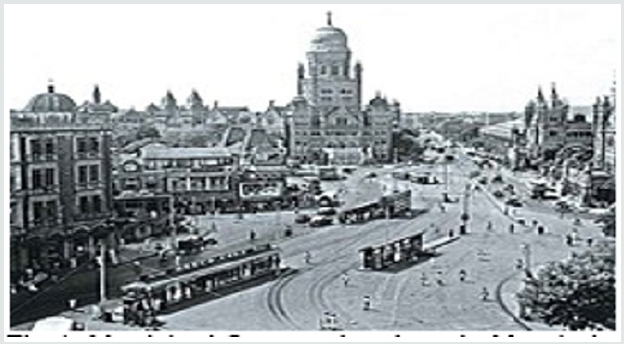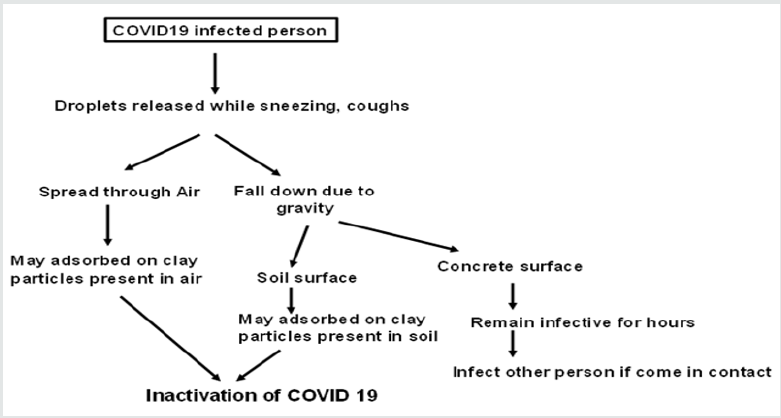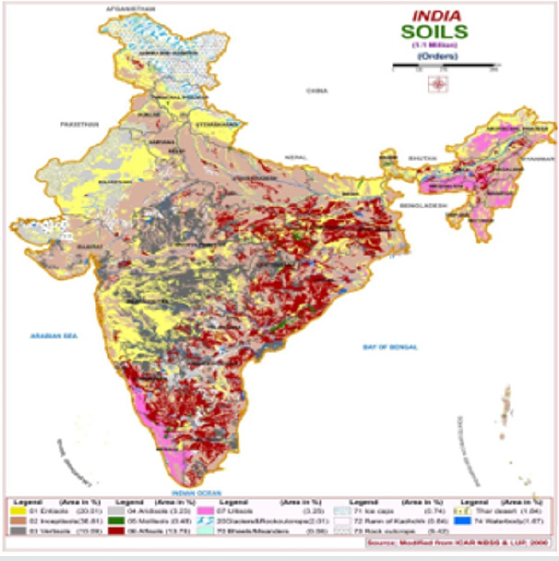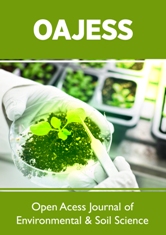
Lupine Publishers Group
Lupine Publishers
Menu
ISSN: 2641-6794
Research Article2641-6794 
Preventive Measures against Transmission and Multiplication of COVID-19 Following the Simple Natural Laws with Soil, Clay, and Biodiversity Volume 5 - Issue 2
Bipin B Mishra*#, Richa Roy**, Surendra K Singh***, Sanjeet Kr Sharma**, Bishun Deo Prasad*, Sanjay K Choudhary***, Ajay K Jha*** and Sangita Sahni****
- Bihar Agricultural University, Sabour, Bhagalpur, India
- **TM Bhagalpur University, Bhagalpur
- ***ICAR-Central Coastal Research Institute, Ella Road, Goa
- ****Dr. Rajendra Prasad Central Agricultural University, Dholi, Pusa, Samastipur, Bihar, India
Received: June 05, 2020; Published: June 30, 2020
Corresponding author: Bipin B Mishra, Bihar Agricultural University, Sabour, Bhagalpur, India
DOI: 10.32474/OAJESS.2020.05.000210
Abstract
- Abstract
- Introduction
- Viruses vs Coronaviruses (COVID 19)
- Urbanization: Some Questions ?
- Adsorption of organic molecules and viruses on clay surface
- Fate of COVID 19 in rural areas
- Towards slowing down transmission and multiplication
- Supporting Facts and Survey
- Preventive measures (COVID-19): Recommendations
- Conclusion
- References
A novel coronavirus (COVID-19 virus) outbreak has caused a global pandemic resulting in huge number of infections and thousands of deaths worldwide. The present review is an effort to establish the preventive measures based on biodegradability as well as adsorption of specific part of such viruses during clay-protein interactions in contact with soil surface. Even the biodegradability of many organic compounds and molecules is altered and the activity of enzymes is adversely affected upon their adsorption to the soil mineral surfaces and clays. Viruses have in general interconnection and interdependence within aboveground and underground biodiversity covering aerosol (gas), water (liquid) and soil or sediment (solid) and are subject to undergo biodegradation following the biogeochemical cycling. Available reports suggest that Covid-19 is by and large associated to certain RNA-viruses that may undergo structural distortion if they fall in direct contact with colloidal fraction of soil minerals preferably montmorillonite or bentonite as in Maharastra and other parts of India. Either aerosols or exposed surface soils in rural areas would delay transmission as well as multiplication of COVID-19. This review highlights on relevance of soil based natural preventive measures to slowdown the spread of COVID-19 following certain yardsticks. Such exploratory approach may help to eradicate such global pandemic.
Keywords: COVID-19; Biodegradability; Clay-organic interaction, Rural ecology; Montmorillonite clay; Natural preventive measures; Eradication
Introduction
- Abstract
- Introduction
- Viruses vs Coronaviruses (COVID 19)
- Urbanization: Some Questions ?
- Adsorption of organic molecules and viruses on clay surface
- Fate of COVID 19 in rural areas
- Towards slowing down transmission and multiplication
- Supporting Facts and Survey
- Preventive measures (COVID-19): Recommendations
- Conclusion
- References
Science works to discover the functioning of the universe.
All theories and methods in science are intended for successful
accomplishments of the human race. Science works virtually in
a closed system by assumptions on defined model representing
the truth and reality within some hypothetical yardsticks. But
in reality, nothing is closed, and the concept of interconnection
and interdependence are the basic framework that needs to be
discovered jointly applying the most refined principles with Nexus
Approach. If medical science is applying its role, for example, in
accomplishment of the human race, relevance of other branches
of science including environmental and soil science may not be
overlooked, if fall in nexus concept. In fact, soil is a nexus tool
that controls not only the surrounding environments but all other
components like land, water, climate, ecosystem, food, and energy.
Humans are living at the lithosphere-hydrosphere-atmosphere
interface of the Earth and interconnected with aboveground and
belowground biodiversity, wherein interdependence is controlled
by biogeochemical cycles. Man can survive for a week without
food, for a few days without water but not beyond a few minutes
without air. So, the Earth’s atmosphere is vital to survival of
everyone’s life. This signifies the relevance of interconnection and
its security for stability. Other living animals have by and large
enriched the resources in their own ways, but being creative and
aspirant, humans have damaged entire natural laws. Urbanization,
for example, is one of the most disastrous human approaches
intended to disconnect Earth’s atmosphere and Earth’s lithosphere
(ground with soil and vegetation) wherein underground as well as
aboveground biodiversity is virtually inactive. In fact, lithosphere is the outer solid layer of the Earth’s crust and the lowest boundary of
atmosphere that includes rocks, unconsolidated parent materials
and soils intending to interactions with sunlight, moisture and
microbial communities including various viruses also [1].
Soil is the major environmental reservoir of many pathogenic
viruses. Unfortunately, the soil biodiversity particularly in cities and
metropolitan cities is virtually inactive as being virtually detached
or weakly attached to Earth’s atmosphere because of manmade
compacted ground surface. Coronavirus (COVID 19) develops
with a positive single stranded RNA genome [2]. The positively
charged RNA lining over coronavirus indicated a clue to develop
an association of such viruses with negatively charges soil clays
preferably bentonite or montmorollonite clay atleast to slow down
their spread [3,4]. The fact that many soil minerals react with and
adsorb organic compounds or humic molecules is of great benefit
to mankind [5,6]. In aligned to this is the biogeochemical cycles
through which the specific chemical elements of the protoplasm
circulate in the biosphere from environment to organism and back
to the environment. Nitrogen and sulphur cycles, for example,
consist of four parts [7]. The COVID 19 pandemic may be natural
or manmade, but reports say that it is a group of viruses, originated
from China. Its structure is almost established by world’s virologists.
Viruses vs Coronaviruses (COVID 19)
- Abstract
- Introduction
- Viruses vs Coronaviruses (COVID 19)
- Urbanization: Some Questions ?
- Adsorption of organic molecules and viruses on clay surface
- Fate of COVID 19 in rural areas
- Towards slowing down transmission and multiplication
- Supporting Facts and Survey
- Preventive measures (COVID-19): Recommendations
- Conclusion
- References
The virus is smallest in size among bacteria, algae, and fungi.
The size of viruses ranges from a few tens to a few hundreds of
nm, which is equal to 1/100 to 1/1000 of the normal cell of living
organism. Viruses can infect bacteria as well. A virus is a section
of DNA or RNA enclosed by a protein shell. The whole community
is the integral part of biodiversity. The belowground communities
are tightly linked to aboveground communities through trophic
interactions, biogeochemical cycling, and plant-soil feedbacks,
and these interactions ultimately govern ecosystem functioning
[8,9]. However, our understanding of belowground communities
is limited compared with our understanding of aboveground
communities [8,10].
Rao [11] reported that the potential adsorbents found in marine
water includes clays (montmorillonite, kaolinite, bentonite, illite),
aquatic life forms (algae, bacteria), silts, and sediments, though the
exact mechanism of increased virus survival due to adsorption to
solids and sedimentary particulates is unknown. But they opined
an approximately 10 to10000 fold higher concentration of virus
in sediment than in the overlying water (Rao et al 1986). Viruses
have been isolated from soils receiving domestic wastewater.
Three different soil types containing 81%, 41% and 7.6% sand
were examined for their ability. The great majority of viruses were
detected within the first 15 cm of soil below the effluent application
lines. Several isolates were found at a depth of 85 cm and single
isolations at 100- 120 cm. Hurstetal [12] recovered 91% of seeded
poliovirus from the top 2.5 cm of soil. Obviously, viruses have
association with soil biodiversity Hopkins [13] being maximum
around the soil surface.
Singh [14] reported in an exciting interview that four antiviral
drugs inhibited replication of the coronavirus that causes COVID-19
and expected to have an imminent cure. Singh [14] explained,
“We are developing what is called RNA polymerase inhibitors of
coronavirus in our lab through a collaboration with the Karolinska
Institute, Stockholm, Sweden. He added that RNA polymerase is an
enzyme that is responsible for copying a DNA sequence into an RNA
sequence, during the process of transcription. Covid-19 is an RNA
virus “We have already identified a small molecule that inhibits RNA
polymerase from SARS-CoV-2 that causes COVID-19. He opined
that this small molecule or its derivative can be a drug against
COVID-19. Singh [14] with his team at the University of Missouri
examined whether four antiviral drugs- remdesivir, 5-fluorouracil,
ribavirin and favipiravir could help in treating COVID-19 and found
that all four block the virus’s RNA proteins from making copies of
the virus. If replication can be stopped or inhibited, the infection
can be overcome. “When we said identified we meant that they
can be effective against SARS-CoV-2 that is the causative agent of
COVID-19.”
Urbanization: Some Questions ?
- Abstract
- Introduction
- Viruses vs Coronaviruses (COVID 19)
- Urbanization: Some Questions ?
- Adsorption of organic molecules and viruses on clay surface
- Fate of COVID 19 in rural areas
- Towards slowing down transmission and multiplication
- Supporting Facts and Survey
- Preventive measures (COVID-19): Recommendations
- Conclusion
- References
Humans by virtue of reasoning power since their evolution captured the land according to availability and ownership. In doing so, they violate the natural laws and promote degradation of natural resources. The humans promoted urbanization. The urbanization and the resulting high-density population are exerting an increasing demand for environmental management, but it is not so easy. During urban development process, the most terrifying situation is the irreversible process of making the earth’s surface compacted with concretion being made linked to concrete roads, seepage, buildings and play grounds in such a planned way that the earth’s atmosphere is virtually got detached from lithospheric ground and soils virtually irreversibly (Figures 1&2). In fact, Earth’s atmosphere is at risk especially due to urbanization. Herein, three vital disturbances do occur:
(i) Whole urban areas are virtually least interconnected to
active biodiversity either with aboveground or underground
biodiversity due to concrete packing. Any new microorganism
or virus is transmitted by some means remains active following
the uninterrupted high multiplication rate.
(ii) Urban areas have high population density and if mode of
viral transmission is from man to man, such environment is the
most positive in favoring the viral spread, COVID 19.
(iii) In metropolitan cities, the area is by and large filled or
covered with concrete permanently. Such manmade planned
activities lead virtually to disconnect Earth’s atmosphere to
its ground. This could be experienced in frequently occurring
thunderstorms and lightening around city areas causing
casualties too during recent days.
(iv) Soils or clays and their interactive association with
organic matter including enzymes or proteins are least active
and appreciated.
Earth Sciences, Northern Illinois University, USA on February 18,
2015 stated that compacted or metropolitan cities can spawn more
thunderstorms based on their findings (Figure 3).Their research
demonstrates that urbanization has led to more thunderstorm
initiation events in Atlanta than would have occurred over natural
vegetation. This is one example to pinpoint how urbanization is
against nature as a whole. In India, the frequency followed by fatality
around most of the cities due solely to intense thunderstorms is
now regularly experienced during rains. Obviously, soil is a nexus
tool to keep atmosphere and lithosphere interconnected, which is
at risk due to urbanization.
The atmosphere being the integral part of the Earth looks simply like an envelope surrounding the earth’s lithosphere and hydrosphere, wherein six spectra are playing major roles in restoring the equilibrium for a climate. These are physical state and stability of the earth i.e. planetary physical spectrum, electromagnetic-nuclear spectrum besides chemical, biological, pedologic and anthropogenic spectra (Figure 4) as reported by Mishra & Richa [15]. In urban areas, all chemical, biological and pedogenic spectra are disturbed primary due to anthropogenic spectra and interconnection and interdependence among all six are at panic point of imbalance. Biodiversity is one that is also affected adversely primarily by anthropogenic factors.
Figure 4: Principles of strategic planning to combat with challenges of climate change using integrated management inputs (Mishra and Richa 2014).

As a result of cumulative impacts, the COVID 19 viruses in cities are spreading very fast due to man to man transmission as well as multiplying with full momentum, since no proper check or restriction in cities are normally possible. Soil biodiversity refers simply to a huge laboratory of microorganisms which are often in association with viruses. Soil environment is a strange wherein clay types perform unique functions in attaining aboveground and underground biological stability due to their high surface area, electrostatic features, biogeochemical cycling etc. Once COVID-19 is trapped by clay particles either kaolinite or most preferably bentonite, it is pathogenic features would be minimized, but it requires systematic investigation. In true sense, soil is least appreciated due solely to the fact that soil what we see is beneath our feet, but it is integral part of whole living systems. Not only survival and nourishment but our livelihood is directly controlled by soil. Soil in many respects is strange like “space”, but it is full of wisdom that is being captured widely and most reliably. COVID 19 viruses in contact with soil and its clay fractions will be weakened and controlled naturally, if efforts are assured.
Adsorption of organic molecules and viruses on clay surface
- Abstract
- Introduction
- Viruses vs Coronaviruses (COVID 19)
- Urbanization: Some Questions ?
- Adsorption of organic molecules and viruses on clay surface
- Fate of COVID 19 in rural areas
- Towards slowing down transmission and multiplication
- Supporting Facts and Survey
- Preventive measures (COVID-19): Recommendations
- Conclusion
- References
Soil dust in environment or aerosol is primarily the clay
particles. All surface soils have varying proportion of sand, silt,
and clay wherein clay is the most active due to high surface area,
surface charge distribution and interaction with organic molecules.
Smectite especially montmorillonite or bentonite in particular
is the most versatile group of catalysts being played in probiotic
chemistry. Due to polarization of water molecules coordinated
to intercalated cations, such minerals act as powerful Bronsted
acids (Raman and Raman 1989). These clays may donate protons
through transfer of a proton from an already protonated molecule
in the exchange couple to another more basic molecule in solution.
Raman & Mortland [16] reported several such proton transfer
reactions. Caims-Smith (1982) forwarded a revolutionary fact
involving clays as the initial genetic material in his book Genetic
Takeover, in which he postulated that our first ancestor might be
the inorganic clay genes and emphasized that our first ancestor
might have been inorganic clay gene and DNA could not have been
the first genetic material.
Clay minerals can take up a wide range and variety of organic
molecules because of their extensive surface area, layer structure,
and surface charge characteristics. Besides, clay minerals can
shield these molecules from cosmic and ultraviolet radiation, and
catalyze their polymerization [3,17]. The proposal that ribonucleic
acid (RNA) can act as both a storehouse of genetic information and
an enzyme-like catalyst in the primordial Earth, has stimulated
research into the ability of clay minerals to catalyze the formation
of RNA from its (activated) monomers. After outlining the probable
role of clay minerals in chemical evolution and the origins of life, and
summarizing clay minerals structures, we describe the interactions
of clay minerals with nucleic acid bases, nucleosides, nucleotides,
polynucleotides, and nucleic acids [3].
van der Waals forces often act in adsorption of viruses
(phages) to colloid materials. Rao [11] reported that the potential
adsorbents found in marine water includes clays (montmorillonite,
kaolinite, bentonite, illite), aquatic life forms (algae, bacteria), silts,
and sediments, though the exact mechanism of increased virus
survival due to adsorption to solids and sedimentary particulates
is unknown. But they opined an approximately 10 to10000 fold
higher concentration of virus in sediment than in the overlying
water at sites in both Texas and Florida [11] .
Fate of COVID 19 in rural areas
- Abstract
- Introduction
- Viruses vs Coronaviruses (COVID 19)
- Urbanization: Some Questions ?
- Adsorption of organic molecules and viruses on clay surface
- Fate of COVID 19 in rural areas
- Towards slowing down transmission and multiplication
- Supporting Facts and Survey
- Preventive measures (COVID-19): Recommendations
- Conclusion
- References
As against cities, the rural areas are not so populated, and houses are specious and not built closely. The soils and landscapes are open for agriculture, forestry, plantation, and pasture purposes, wherein biodiversity is active. Both aboveground biodiversity because of windblown dust (clay size) in aerosol and underground biodiversity in the soil environment are active depending on soil environment, organic matter decomposition and microbial communities in soil. The day temperature in major parts of India, for example, is more than 40 degree C which makes better environment for biogeochemical cycling as well as clay-organic interactions, wherein RNA of COVID 19 might be adsorbed and partly distorted. Dry land appears as a relevant environment, since in such conditions,dehydration-hydration cycles that allow the polymerization of nucleotides occur [18]. Clay minerals have a strong affinity for organic molecules and can catalyze their reactions [19]. Pedreira-Segade [20] reviewed on how the nucleotides would, the building blocks of RNA and DNA have interacted with phyllosilicates (clays) under various physic-chemical conditions. The binding of DNA and RNA onto mica in presence of transition metals is widely acknowledged [21]. As the recent review by Yu Chen and colleagues from China in the Journal of Medical Virology points out (https://doi.org/10.1002/jmv.25681), COVID19 has RNA-based genomes and subgenomes in its polyprotein sequence. The link between non-enzymatic RNA polymerization and RNA selfreplication is a key step towards the “RNA world” and still far from being solved, despite extensive research. Clay minerals, lipids and, more recently, peptides were found to catalyze the non-enzymatic synthesis of RNA oligomers [22]. Herein, a review of the main models for the formation of the first RNA polymers is presented in such a way as to emphasize the cooperation between life’s building blocks in their emergence and evolution. A logical outcome of the previous results is a combination of these models, in which RNA polymerization might have been catalyzed cooperatively by clays, lipids and peptides in one multi-component prebiotic soup. The resulting RNAs and oligopeptides might have mutualistically evolved towards functional RNAs and catalytic peptides, preceding the first RNA replication, thus supporting an RNA-peptide world. The investigation of such a system is a formidable challenge, given its complexity deriving from a tremendously large number of reactants and innumerable products. A rudimentary experimental design is outlined, which could be used in an initial attempt to study a quaternary component system.
Raman and Mortland [23] presented several proton transfer reactions in which smectite/montmorillonite may donate protons through transfer of a proton from an already protonated molecule in the exchange couple to another more basic molecule in solution. Raman and Raman (1989) reviewed details on role of montmorillonite as catalysts, while Ghosh and Mishra [24] summarized the mode of clay organic interactions highlighting polarity in adsorption. Preventing the spread of the COVID 19 from urban to rural areas where majority of the population in India, for example, shelter is a key concern, in which one must follow strictly the practice of social/physical distancing (at least 1 m apart), wearing of face masks and frequent hand hygiene and sanitizing to control the infection and its spread as per WHO (World Health Organization).
Towards slowing down transmission and multiplication
- Abstract
- Introduction
- Viruses vs Coronaviruses (COVID 19)
- Urbanization: Some Questions ?
- Adsorption of organic molecules and viruses on clay surface
- Fate of COVID 19 in rural areas
- Towards slowing down transmission and multiplication
- Supporting Facts and Survey
- Preventive measures (COVID-19): Recommendations
- Conclusion
- References
The whole mechanism of COVID-19 for transmission, spread
and multiplication within a short time is yet a mystery. However, it
is advocated that transmission of COVID -19 follows three modes,
namely contact (direct or indirect), droplet spray for short range
transmission and aerosol in long-range transmission (airborne
transmission). Although the main vehicle for its spread is contact
but the other modes (droplet spray and aerosol) could not be
ruled out. Recent report published in The New England Journal
of Medicine indicates the viability of COVID 19 in aerosols for at
least 3 hrs [25]. Even six feet of distance barrier are not sufficient
to stop its spread through aerosol. However, the gravity and air
flow causing most virus droplets to float, spread, and adsorbed
to the air dust, soil and clays or ground. Plastered, cemented or
plastic covered floor or ground is virtually inert to COVID-19 being
transmitted in any mode. Importantly, the soil particles containing
clays preferably bentonite with appreciable amount of organic
matter seems to be preventive to COVID-19. Following any mode of
transmission, once this virus comes in contact with soil dust (clay
particles) or soil surface, adsorption of viruses becomes possible
following the suitable principles for clay-protien or clay-enzyme
interactions [16]&[23,24]. The extent of adsorption of COVID 19
by soil or clay or bentonite needs to be studied and validated. A
plethora of reports indicates that the RNA decomposed very quickly
if COVID-19 lost its coat (capsid). The protonated montmorillonite,
titrated to pH 6−7, serves as a catalyst for the formation of RNA
oligomers [26].
It is well documented that bentonite or montmorillonite clays
adsorb the pathogenic viruses including human viruses [27-29].
The Black cotton Vertisols occurring widely in Maharastra are
rich in montmorillonite and other parts of India including Tal
land soils of Bihar. Besides other clay types like kaolinite and illite
may also serve the purpose for adsorption depending upon ionic
strength [28].In vitro study indicates that clay particles adsorb
bovine coronavirus [30]. Based on above finding we hypothesized
that the spike proteins found on the surface of COVID-19serves
as the attachment protein with other surface including bentonite
clay’s interlayers. Further the binding or adsorption of COVID-19
may inhibit their multiplication as well as further spread (Figures
5 & 6). As such, soil and clay may slow down the speculated fast
multiplication of COVID-19 and spread in any mode.
Supporting Facts and Survey
- Abstract
- Introduction
- Viruses vs Coronaviruses (COVID 19)
- Urbanization: Some Questions ?
- Adsorption of organic molecules and viruses on clay surface
- Fate of COVID 19 in rural areas
- Towards slowing down transmission and multiplication
- Supporting Facts and Survey
- Preventive measures (COVID-19): Recommendations
- Conclusion
- References
Soil is a reservoir of genetic diversity and key players in
geochemical processes. Soil viruses are of great importance as
they may influence the ecology of soil biological communities
through both an ability to transfer genes from host to host and
as a potential cause of microbial mortality. Consequently, viruses
are major players in global geochemical cycles, influencing the
turnover and concentration of nutrients and gases [12,31]. In fact,
environmental virology deals with the study of viruses that are
transmitted through environmental factors like air, water, soil, or
susceptible surface or even food. However, certain nonenveloped
enteric pathogenic viruses enter the environment through the
discharge of cough and waste materials from infected individuals
and get transmitted to susceptible individuals and thus continue the
cycle of infection. SARS being an emerging disease is severe acute
respiratory syndrome (SARS) as experienced in November 2002
[32]. The mode of transmission of SARS coronavirus is the direct
mucous membrane contact with infectious respiratory droplets.
The RNA-dependent RNA polymerase (RdRp, also named nsp12)
is the central component of coronaviral replication/transcription
machinery and appears to be a primary target for the antiviral drug
[33].The “body” of COVID-19 is basically a genome enveloped in
glycoproteins, with a smear of fat and bearing the crown of spikes
that inspired the name “coronavirus.” The genome is a single strand
of RNA that is termed “positive-sense.” That means that the infected
cell treats the viral genome as if its own messenger RNA (mRNA),
translating it into proteins [34].
With relaxation in lockdown in India, rural areas expect to see
greater benefits compared to urban India, since fewer covid-19
cases are only detected in rural areas so far [35]. Urban residents
are more at risk for person-to-person spread of the COVID 19, but
those in rural areas are safe [36]. The novel corona virus can spread
through direct transmission, contact transmission, or aerosol
transmission. Aerosol transmission refers to the mixing of the virus
with droplets in the air to form aerosols, which causes infection
after inhalation [37].Based on observations, Anuradha [38]
reported that use of soap or ash for washing hands before feeding
the child reduced hand contamination significantly. Bloomfield and
Nath [39] also studied the use of ash and soil for handwashing. The
Sree Chitra Thirunal Institute of Medical Sciences and Technology,
one of the leading medical institutes in Kerala, recently unveiled
a testing kit, the Chitra Gene LAMP-N for COVID-19, produced by
its team [40]. It is to believe that burial of COVID 19 victims in
soil being potentially active for microbial decomposition would
distort the viral structure with time [7]&[41-43]. By and large, the
biogeochemical cycling in soil-clay-microorganism/biodiversitywater-
environment-sunlight nexus works naturally. Importantly,
based on WHO report, respiratory infections may be transmitted
through droplets of different sizes: when the droplet particles are
>5-10 μm in diameter they are referred to as respiratory droplets,
and when they are <5μm in diameter, they are referred to as droplet
nuclei. According to current evidence, COVID-19 virus is primarily
transmitted between people through respiratory droplets and
contact routes [44].
Till date there is no published report on air mediated transfer
of COVID-19 or overlooked [45]. Study on two Wuhan hospitals in
China during the COVID-19 outbreak in February and March 2020,
detected SARS-CoV-2 RNA in aerosols of crowding prone areas [46].
Some medical studies also speculated the spread of COVID-19 RNA
in air samples (aerosol). The existence of positively charged single
stranded RNA (+ssRNA) in COVID 19 virus is well documented. A plethora of reports indicates the formation of nucleic acidclay
complexes (Franchi et al., 2013; Beall et al., 2009) [47,48].
Therefore, we hypothesize that the clays already existing in air
interact with positive strand RNA of COVID 19 virus and form the
complex and so the COVID 19 virus gradually may appear inactive.
Preventive measures (COVID-19): Recommendations
- Abstract
- Introduction
- Viruses vs Coronaviruses (COVID 19)
- Urbanization: Some Questions ?
- Adsorption of organic molecules and viruses on clay surface
- Fate of COVID 19 in rural areas
- Towards slowing down transmission and multiplication
- Supporting Facts and Survey
- Preventive measures (COVID-19): Recommendations
- Conclusion
- References
Until now, no vaccination or medical treatment for COVID 19 is confirmed [49]. In India too, the situation is disastrous particularly in Maharastra, Madhya Pradesh and Gujarat. Maharastra is very rich in black cotton soils (Vertisols) with very high amount of montmorillonite or bentonite clays as depicted in map Figure 7. Although other clay types are also capable of interactions with organic molecules, bentonite is the most suitable and may be efficient to curb the normal structure of COVID 19. Accordingly, the following action plan is being forwarded to test under some trials in rural area particularly in Maharastra, India.
(i) Selection of at least half acre of land undertilled bare soil
in a remote rural area preferably under farming and declare it
protected after fencing for all medical treatment of mild COVID
19 patients being shifted from compacted urban treatment
centres from Mumbai and Pune.
(ii) The protected area may be disinfected with sodium
hypochlorite (NaOCl) to kill the aboveground infectious
microbes and viruses likely to be present in aerosol above the
soil surface within the protected area.
(iii) Then transfer suitable number of mild COVID 19
patients, may be 100 or 200 in number, from Mumbai or Pune
metropolitan cities to this protectedtreatment point while
restoring all medical advisories.
(iv) Also, to continue all medical treatments as already
prescribed to the mild patients maintaining physical distancing
and others as recommended medically by WHO.
(v) Based on observations as outlined in this review, both
transmission as well as multiplication of corona viruses in
such new set of environments surrounded with soil and clay
materials is likely to be slowed down and recovery will be
faster.
(vi) In fact, the structure of COVID 19 will get gradually
distorted during its interactions with clays and become inactive
and COVID 19 is expected to be eradicated.
Sodium hypochlorite (NaOCl) is known to decompose even
the resistant organic carbon in soil without affecting its inorganic
constituents as well as mineral composition [50,51].Of course, the
above points need to be tested or examined [52-61]. Even if the
infection is transmitted through migration, it is expected for early
recovery if the patients stay in village area surrounded with open
or exposed soils [62,63]. Even in semi-urban area of Bhagalpur, one
practice is being made common to till the soil in kitchen garden and
lawn lying with residential house Figure 8.
Conclusion
- Abstract
- Introduction
- Viruses vs Coronaviruses (COVID 19)
- Urbanization: Some Questions ?
- Adsorption of organic molecules and viruses on clay surface
- Fate of COVID 19 in rural areas
- Towards slowing down transmission and multiplication
- Supporting Facts and Survey
- Preventive measures (COVID-19): Recommendations
- Conclusion
- References
Conclusively, we prefer to encourage natural environment preferably in rural areas to get rid of this COVID-19, where specific clay rich soils are open and where Earth’s groundatmosphere connectivity is by and large optimal. Soil in its natural state is otherwise a nexus tool that remains interconnected as well as interdependent to all surrounding landform-hydrologybiodiversity- sunlight-climate-vegetation in order to restore livelihood security, wherein the contributions of soil biodiversity is vital. It is therefore presumed that the COVID-19 would not be so infectious if they are in contact with active soils rich in type specific clays and even with organic matter. In order to eradicate coronavirus (COVID 19), precautions may be taken to burn the dead body. However, such exploratory report needs to be validated systematically across the globe.
References
- Abstract
- Introduction
- Viruses vs Coronaviruses (COVID 19)
- Urbanization: Some Questions ?
- Adsorption of organic molecules and viruses on clay surface
- Fate of COVID 19 in rural areas
- Towards slowing down transmission and multiplication
- Supporting Facts and Survey
- Preventive measures (COVID-19): Recommendations
- Conclusion
- References
- Pirtle EC and Beran GW (1991)Virus survival in the environment. Rev sci tech Off intEpiz 10(3): 733-748.
- Mousavizadeh L, Ghasemi S (2020) GenotypeandphenotypeofCOVID19:Theirrolesin pathogenesis. Journal of Microbiology, Immunology and Infection.
- Hushizume H van der Gaast S and Theng BKG (2013) Interactions of Clay Minerals with RNA Components. Evolutionary Biology: Exobiology and Evolutionary Mechanisms pp. 61-79.
- Mishra S and Carnahan R (2020) Coronavirus: A new type of vaccine using RNA could help defeat COVID 19.
- Harter RD (1977) Reactions of minerals with organic compounds in the soil. In. Minerals in Soil Environments, JB Dixon et al., (Eds.), Soil Science Society of America, Madison, USA, pp. 709-740.
- Schnitzer M and Kodama H (1977) Reactions of minerals with soil humic substances. In. Minerals in Soil Environments, JB Dixon et al., (Eds.), Soil Science Society of America, Madison, USA, Pp. 741-770.
- Saraswat PK, Nirwan PS, Saraswat S, Mathur P (2005) Review Article: Biodegradation of dead bodies including human cadavers and their safe disposal with reference to mortuary practice. In. Mortuary& bio-medicalwaste, (EdS.), Departmentof Forensic Medicine & Toxicology JLN Ajmer(Rajasthan). Journal Indian Academy of Forensic Medicine 30(4): 273-280.
- BardgettRDand Wardle DA (2010) Aboveground-Belowground Linkages: Biotic Interactions, Ecosystem Processes, and Global Change. Oxford, UK.
- van der Putten WH, Bardgett RD, Bever JD, Bezemer TM, Casper BB, and et al., (2013) Plant-soil feedbacks: the past, the present and the future challenges. J Ecol 101(2): 265-276.
- Decaëns T (2010) Macroecological patterns in soil communities. Glob. Ecol. Biogeogr 19: 287-302.
- Rao VC, Metcalf T and Melnick J (1986) Human viruses in sediments, sludges, and soils. Bulletin of the World Health Organization 64(1): 1-14.
- Hurst CJ, Gerba CP, Cech I (1980) Effects of environmental variables and soil characteristics on virus survival in soil. Appl Environ Microbiol 40: 1067-1079.
- Hopkins DW, Wiltshire PEJ, Turner DB (2000) Microbial characteristics of soils from graves: an investigation at the interface of soil microbiology and forensic science. Applied Soil Ecology14(3): 283-288.
- Singh K (2020) Interview on COVID 19 antivirus drugs. Bond Life Sciences Center, University of Missouri USA.
- Mishra BB and Richa Roy (2014) Global climate change: Myth, Reality & Mitigation. In. Climate Dynamics in Horticultural Science, Vol II (Eds.), ML Choudhary et al., Apple Academic Press Inc., Canada, Pp. 126-139.
- Raman S and Raman KV (1989) Smectites as catalysts. Clay Research 8(1-2): 53-66.
- Hashizume H (2012) Role of clay minerals in chemical evolution and the origin of life. IntechOpen.
- Deamer DW and Georgiou CD (2015) Hydrothermal conditions and the origin of cellular life. Astrobiology 15(2): 1091-1095.
- Giese RF, Van Oss CJ, Yariv S, Cross HO (2002) Clay complexes and interactions. Ed. Marcel Dekker. In. Organophilicity and hydrophobicity of ornano-clays, NY, USA, pp. 175-192.
- Pedreira-Segade U, Hao J and Daniel I (2018) How do nucleotides adsorb onto clays? Life (Basel) 8(4): 59.
- Hansma HG and Laney DE (1996) DNA binding to mica correlates with cationic radius: Assay by atomic force microscopy. Biophys J 70(4): 1933-1939.
- Kaddour H and Sahai N (2014) Synergism and mutualism in non-enzymatic RNA polymerization. Life (Basel) 4(4): 598-620.
- Raman KV and Mortland MM (1969) Proton transfer reactions at clay mineral surfaces. Soil Science Society of America Proceedings. 33(2): 313-317.
- Ghosh SK and Mishra BB (1989) Clay organic interactions. Clay Research 8(1-2): 84-90.
- NEngl J Med 382:16.
- Joshi PC, Aldersley MF, Delano JW, Ferris JP (2009) Mechanism of Montmorillonite Catalysis in the Formation of RNA Oligomers. JAmChemSoc 131(37): 13369-1337.
- Schaub SA and Sagik BP (1975) Association of enteroviruses with natural and artificially introduced colloidal solids in water and infectivity of solids-associated virions. Appl Microbiol 30(2): 212-222.
- Lipson SM and Stotzky G (1983) Adsorption of reovirus to clay minerals: effects of cation-exchange capacity, cation saturation, and surface area. Appl Environ Microbiol 46(3): 673-682.
- Chattopadhyay S and Puls RW (1999) Adsorption of bacteriophages on clay minerals. Environ. Sci. Technol 33: 3609-3614.
- Clark KJ, Sarr AB, Grant PG, Phillips TD, Woode GN (1998) In vitro studies on the use of clay, clay minerals and charcoal to adsorb bovine rotavirus and bovine coronavirus. Vet Microbiol 63(2): 137-146.
- Limits M, Jia Z, Nakayama N and Adamawa S (2008) Ecology of viruses in soils: past, present, and future perspectives. Soil Science and Plant Nutrition 54(1): 1-32.
- Ksiazek TG, Erdman D, Goldsmith CS and Zaki SR (2003) A Novel Coronavirus Associated with Severe Acute Respiratory Syndrome. New England J Medicine 348(20): 1953-1966.
- Gao Y , Yan L, Huang Y, Liu F , Zhao Y, and et al., (2020) Structure of the RNA-dependent RNA Polymerase From COVID-19 Virus. Science 368(6492): 779-782.
- Lewis R (2020) COVID-19 Vaccine Will Close in on the Spikes. PLOS BLOGSDNA Science.
- https://www.livemint.com/news/india/rural-india-s-covid-19-challenge-low-access-to-soap-and-water-11587375522654.html.
- https://www.dailyyonder.com/rural-areas-at-less-risk-of-coronavirus-currently/2020/03/04.
- https://health.economictimes.indiatimes.com/news/diagnostics/coronavirus-can-spread-by-direct-transmission-aerosols-says-official/74041454.
- Anuradha P, Yasoda Devi P, Shiva Prakash M (1999) Effect of hand washing agents on bacterial contamination. Indian Journal of Pediatrics 66(1): 7-10.
- Bloomfield SF and Nath KJ (2009) Use of ash and mud for handwashing in low income communities: An International Scientific Forum on Home Hygiene (IFH)expert review.
- Rediff News (2020) Report from Kerala, 4th May 2020.
- Dent BB, Forbes SL, and Stuart BH (2004) Review of human decomposition processes in soil. Environmental Geology 45: 576-585.
- Forbes SL, Dent BB, Stuart DH (2005) The effect of soil type on adipocere formation. Forensic Science International 154(1): 35-43.
- Galloway A, Birkby WH, Jones AM, Henry TH, Parks BO (1989) Decay rates of human remain in an arid environment. Journal of Forensic Sciences 34(3): 607-616.
- Sengupta R (2020) Novel coronavirus disease (COVID-19) in India. Down to Earth.
- https://www.who.int/news-room/commentaries/detail/modes-of-transmission-of-virus-causing-covid-19-implications-for-ipc-precaution-recommendations.
- Liu J, Liao X, Qian S, Yuan J, Wang F, and et al., (2020) Community Transmission of Severe Acute Respiratory Syndrome Coronavirus 2, Shenzhen, China, 2020. Emerging Infectious Diseases 26(6): 1320-1323.
- Franchi M, Bramanti E, Bonzi LM, Orioli PL (1999) Clay-Nucleic Acid Complexes: Characteristics and Implications for the Preservation of Genetic Material in Primeval Habitats. Origins of Life and Evolution of Biospheres 29(3): 297-315.
- Beall GW, Sowersby DS, Roberts RD , Robson MH, and Lewis LK (2009) Analysis of Oligonucleotide DNA Binding and Sedimentation Properties of Montmorillonite Clay Using Ultraviolet Light Spectroscopy. Biomacromolecules 10(1): 105-112.
- Singh P, Srivastav SK, Mittal A, Singh M (2020)COVID-19, the novel coronavirus 2019: current updates and the future. Intern J Res Medical Sci.
- Siregar A (2004) Sodium hypochlorite oxidation reduces soil organic matter concentration. Europian Journal of Soil Science. 56(4): 481-490.
- Zimmermann M and Fuhrer J (2007) Sodium hypochlorite separates an older soil organic matter fraction than acid hydrolysis. Geoderma 139(1-2): 171-179.
- BardgettRDand van der Putten WH (2014) Belowground biodiversity and ecosystem functioning. Nature 515: 505-511.
- PMC2655227, NIHMSID: NIHMS86714.
- PMID: 19061334.
- file:///C:/Users/HP/AppData/Local/Temp/COVID_19_Aerosol_Transmission.htm
- https://www.rediff.com/news/interview/coronavirus-emergence-of-another-coronavirus-is-inevitable/20200513.htm
- https://doi.org/10.1002/jmv.25681
- Ioannidis JPA (2020) Coronavirus disease 2019: The harms of exaggerated information and non-evidence-based measures. European Journal of Clinical Investigation.
- https://phys.org/news/2015-02-urbanization-affect-thunderstorms.html
- https://www.livemint.com/news/india/rural-india-s-covid-19-challenge-low-access-to-soap-and-water-11587375522654.html.
- https://sufficientcertainty.com
- https://www.dailyyonder.com/rural-areas-at-less-risk-of-coronavirus-currently/2020/03/04/).
- Anil Kumar KS, Lalitha M, Shivanand, Sujatha K, Nair KM, and et al. (2020) Major Soil Types andClassification. In. The Soils of India; World Soils Book Series, BB Mishra (Edn.), Springer Nature, pp.82.

Top Editors
-

Mark E Smith
Bio chemistry
University of Texas Medical Branch, USA -

Lawrence A Presley
Department of Criminal Justice
Liberty University, USA -

Thomas W Miller
Department of Psychiatry
University of Kentucky, USA -

Gjumrakch Aliev
Department of Medicine
Gally International Biomedical Research & Consulting LLC, USA -

Christopher Bryant
Department of Urbanisation and Agricultural
Montreal university, USA -

Robert William Frare
Oral & Maxillofacial Pathology
New York University, USA -

Rudolph Modesto Navari
Gastroenterology and Hepatology
University of Alabama, UK -
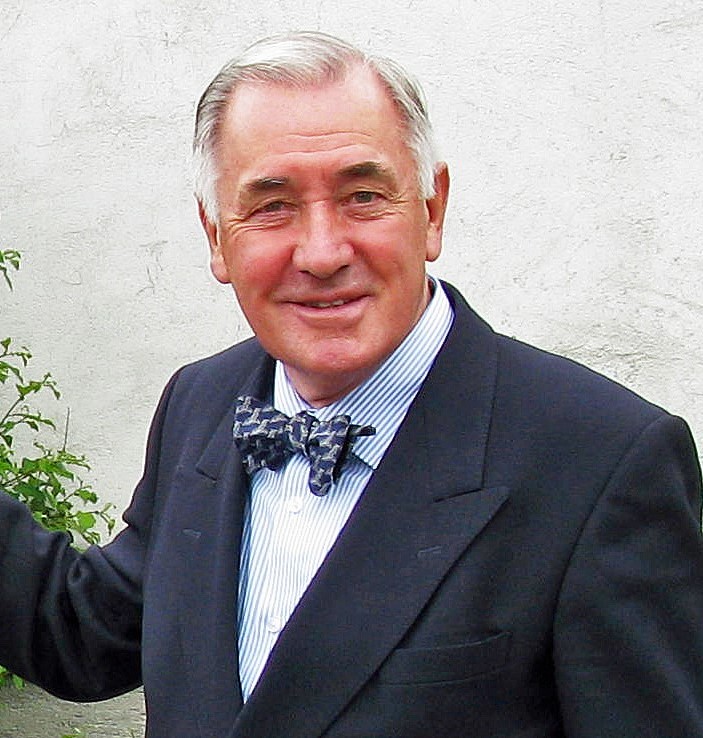
Andrew Hague
Department of Medicine
Universities of Bradford, UK -

George Gregory Buttigieg
Maltese College of Obstetrics and Gynaecology, Europe -

Chen-Hsiung Yeh
Oncology
Circulogene Theranostics, England -
.png)
Emilio Bucio-Carrillo
Radiation Chemistry
National University of Mexico, USA -
.jpg)
Casey J Grenier
Analytical Chemistry
Wentworth Institute of Technology, USA -
Hany Atalah
Minimally Invasive Surgery
Mercer University school of Medicine, USA -

Abu-Hussein Muhamad
Pediatric Dentistry
University of Athens , Greece

The annual scholar awards from Lupine Publishers honor a selected number Read More...




